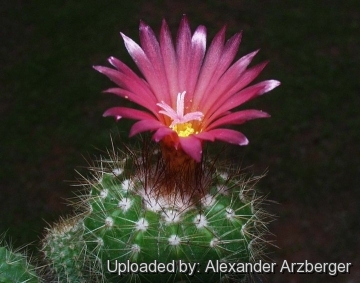Donate now to support the LLIFLE projects.
Your support is critical to our success.
Your support is critical to our success.
= Notocactus horstii f. purpureus (F.Ritter) K.Herm
Internoto 14(2): 64 (1993)
Accepted Scientific Name: Parodia ottonis subs. horstii (F.Ritter) Hofacker
Cactaceae Consensus Init. 6: 12. 1998

Notocactus purpureus (Notocactus horstii f. purpureus) Photo by: Alexander Arzberger
Synonyms:
- Notocactus horstii f. purpureus (F.Ritter) K.Herm
- Notocactus purpureus F.Ritter
See all synonyms of Parodia ottonis
back
Accepted name in llifle Database:Parodia ottonis (Lehm.) N.P.Taylor
Bradleya 5: 93. 1987
Synonymy: 67
- Parodia ottonis (Lehm.) N.P.Taylor
- Cactus ottonis Lehm.
- Echinocactus ottonis (Lehm.) Link & Otto
- Malacocarpus ottonis (Lehm.) Britton & Rose
- Notocactus ottonis (Lehm.) A.Berger
- Peronocactus ottonis (Lehm.) Doweld
- Echinocactus ottonis var. pallidior Monv. ex Lem.
- Echinocactus ottonis var. spinosior Monv. ex Lem.
- Echinocactus tenuispinus var. minor Link & Otto
- Notocactus acutus F.Ritter
- Notocactus oxycostatus f. acutus (F.Ritter) N.Gerloff
- Notocactus arechavaletae (Speg. ex Arechav.) Herter
- Echinocactus acuatus var. arechavaletae K.Schum. ex Speg.
- Echinocactus arechavaletae Speg. ex Arechav.
- Malacocarpus arechavaletae (Speg. ex Arechav.) A.Berger
- Wigginsia arechavaletae (Speg. ex Arechav.) D.M.Porter
- Notocactus arechavaletae var. alacriportanus F.Ritter
- Notocactus arechavaletae var. aureus F.Ritter
- Notocactus ottonis f. aureus (F.Ritter) N.Gerloff & Neduchal
- Notocactus arechavaletae var. buenekeri F.Ritter
- Notocactus arechavaletae var. limiticola F.Ritter
- Notocactus arechavaletae var. nanus F.Ritter
- Notocactus arechavaletae var. rubescens F.Ritter
- Notocactus grandiensis Bergner
- Notocactus maldonadensis (Herter) Herter
- Echinocactus maldonadensis Herter
- Notocactus neo-ottoianus Y.Itô
- Notocactus ottonis var. acutangularis F.Ritter
- Notocactus ottonis var. albispinus Backeb.
- Notocactus ottonis var. elegans Backeb.
- Notocactus ottonis f. elegans (Backeb. & Voll) Havlíček
- Notocactus ottonis var. globularis (F.Ritter) Bergner
- Notocactus globularis F.Ritter
- Notocactus ottonis f. globularis (F.Ritter) N.Gerloff & Neduchal
- Notocactus ottonis var. janousekianus K.Papoušek
- Notocactus ottonis var. nigrispinus H.D.Lück
- Notocactus ottonis var. paraguayensis (Haage jr.) A.Berger ex Backeb.
- Echinocactus ottonis var. paraguayensis Haage jr.
- Echinocactus ottonis f. paraguayensis (Haage jr.) Schelle
- Notocactus ottonis var. rubrispinus Prestlé
- Notocactus ottonis var. schuldtii Kreuz.
- Notocactus oxycostatus var. schuldtii (Kreuz.) N.Gerloff
- Notocactus ottonis var. stenogonus Backeb.
- Notocactus ottonis var. tenebrosus n.n.
- Notocactus ottonis var. tenuispinus (Link & Otto) Borg
- Echinocactus ottonis var. tenuispinus (Link & Otto) Pfeiff.
- Echinocactus ottonis f. tenuispinus (Link & Otto) Schelle
- Echinocactus tenuispinus Link & Otto
- Notocactus neo-ottoianus var. tenuispinus (Link & Otto) Y.Itô
- Notocactus tenuispinus (Link & Otto) Herter
- Notocactus ottonis var. uruguayensis (Arechav.) Frič
- Echinocactus ottonis var. uruguayus Arechav.
- Notocactus uruguayus (Arechav.) Herter
- Notocactus ottonis var. vencluianus Schütz
- Notocactus ruoffii N.Gerloff
- Notocactus minimus var. ruoffii (N.Gerloff) N.Gerloff & Neduchal
- Notocactus tenuispinus f. cristatus P.V.Heath
- Parodia amambayensis (Werderm.) Borg
- Echinocactus amambayensis Werderm.
- Parodia paraguayensis (K.Schum.) Speg.
- Parodia ottonis var. tortuosa (Link & Otto) N.P.Taylor
- Echinocactus ottonis var. tortuosus (Link & Otto) K.Schum.
- Echinocactus ottonis f. tortuosus (Link & Otto) Schelle
- Echinocactus tortuosus Link & Otto
- Notocactus neo-ottoianus var. tortuosus (Link & Otto) Y.Itô
- Notocactus ottonis var. tortuosus (Link & Otto) Borg
Parodia ottonis subs. horstii (F.Ritter) Hofacker
Cactaceae Consensus Init. 6: 12. 1998
Synonymy: 14
- Parodia ottonis subs. horstii (F.Ritter) Hofacker
- Notocactus arechavaletae var. horstii F.Ritter
- Notocactus horstii F.Ritter
- Notocactus ottonis subs. horstii (F.Ritter) Doweld
- Parodia horstii (F.Ritter) N.P.Taylor
- Peronocactus horstii (F.Ritter) Doweld
- Peronocactus ottonis subs. horstii (F.Ritter) Doweld
- Wigginsia nothohorstii (F.Ritter) Doweld
- Notocactus horstii f. muglianus K.Herm
- Notocactus horstii f. purpureiflorus (F.Ritter) K.Herm
- Notocactus horstii f. purpureus (F.Ritter) K.Herm
- Notocactus purpureus F.Ritter
- Notocactus muegelianus T.Engel
back

Notocactus purpureus (Notocactus horstii f. purpureus) Photo by: Alexander Arzberger
Send a photo of this plant.
The gallery now contains thousands of pictures, however it is possible to do even more. We are, of course, seeking photos of species not yet shown in the gallery but not only that, we are also looking for better pictures than those already present. Read More...
The gallery now contains thousands of pictures, however it is possible to do even more. We are, of course, seeking photos of species not yet shown in the gallery but not only that, we are also looking for better pictures than those already present. Read More...
| Your Actions | |
|---|---|
| Back to Notocactus index | |
| Back to Cactaceae index | |
 |
Back to Cacti Encyclopedia index |








